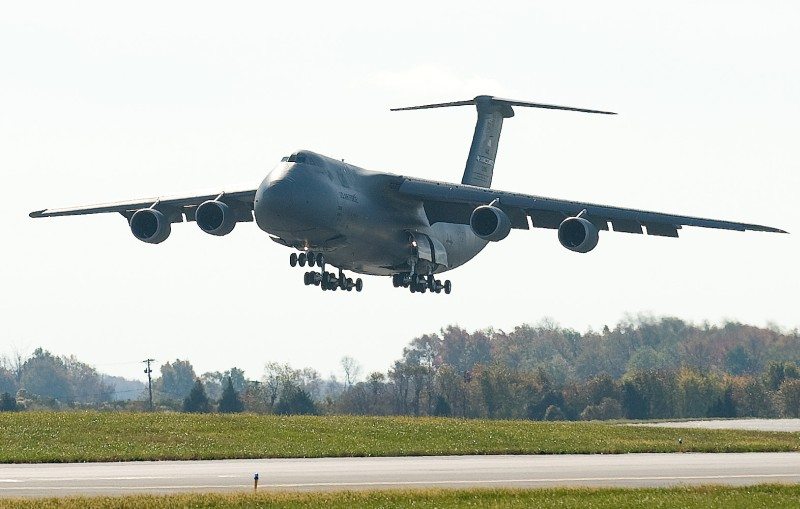Putting in place the most-sweeping strategic planning effort in U.S. Transportation Command’s 25-year history, Air Force Gen. William M. Fraser III, Transcom commander, said his organization is revolutionizing the way the military deploys, sustains and redeploys its forces around the globe.
Fraser assumed his post overseeing the Defense Department’s global air, land and sea transportation enterprise in October 2011. It was a year of unprecedented geopolitical change across the Middle East and Northern Africa; the massive earthquake, tsunami, and nuclear disaster in Japan; the logistical drawdown in Iraq and surge operations in Afghanistan.
In every case, Fraser noted, the combatant commanders responsible for these and every other effort the military conducted turned to Transcom and its unmatched transportation and distribution capabilities to carry out their missions.
Speaking with American Forces Press Service in his headquarters office here, Fraser said he’s been amazed that the people of Transcom, including its service components and commercial and international partners, make such a daunting task look almost easy.
During any given day, he said, the command oversees 100 rail car shipments, 26 ships underway and another nine ships being loaded or offloaded, 2,000 truck cargo shipments, 2,000 household goods movements, 900 airlift sorties, 97 operational air refueling sorties, seven air evacuation sorties and 30 courier deliveries.
“It is fascinating that we are able to do what we do the way that we do it, and I think others enjoy being able to turn to us to provide them options to … accomplish their mission,” Fraser said.
Transcom was never envisioned as a permanent combatant command when it initially stood up in 1987. It was meant to be a planning headquarters, to be activated only in wartime to deal with the associated transportation and logistics challenges.
Operation Desert Storm — the largest deployment of U.S. troops and equipment since the Vietnam War — changed that thinking. “There came a realization that you really need to do in peace what you do in war,” Fraser said.
So for the past two decades, Transcom has matured its processes, evolving into what Fraser calls a “world-class, joint deployment and distribution enterprise that provides unfailing support to our warfighters and their families around the globe.”
The challenge now, he said, is that what has worked so well in the past isn’t necessarily the best formula for the future — particularly in light of budgetary constraints and changing support requirements as the United States draws down in Afghanistan.
“We are at a point in time where things are going to be different,” Fraser said. “We are not going to be as engaged in as many areas constantly, and there is not going to be as much business.”
That, he acknowledged, is one of Transcom’s big challenges moving forward.
A state-of-the-art global transportation and distribution enterprise simply can’t be turned on and off like a spigot, he explained.
The enterprise, Fraser said, relies on ready, well-oiled capabilities within Transcom’s organic assets, provided by the Military Surface Deployment and Distribution Command, Military Sealift Command, Air Mobility Command and Joint Enabling Capabilities Command.
Not as well recognized, he noted, is the key role commercial partners play: contributing ships, cargo space, aircraft and logistics support to complement what the military provides.
“We really rely upon our commercial partners,” Fraser said. “They provide tremendous capability to us, when we need it and where we need it, and we are able to capitalize upon their infrastructure and the capabilities they have to accomplish our mission.”
The general said Transcom’s new strategy recognizes the importance of keeping its organic and commercial enterprises viable so they’re able to support future missions — whether for humanitarian assistance and disaster response or kinetic operations.
The way to do that, Fraser said, is to remain the uncontested “transportation provider of choice” that combatant commanders keep busy supporting their exercises and engagements, even as wartime requirements decrease.
So as it strives to preserve readiness capability, Transcom is focusing on improving its business model to better align resources and processes to support the mission, Fraser said. For example, he noted, the command is investing heavily in information technology to give leaders the tools to make the best — and when feasible, lowest-cost — options as they make transportation and logistics decisions.
And in what Fraser said he considers one of the most important engines for change, Transcom is looking inward, to transform its workforce into “enterprise-focused professionals.” The goal, he explained, is to encourage collaboration, build trust and empower people to make decisions and inspire innovation.
That makes each and every member of Transcom a partner in transforming the command for the future, Fraser said. “I feel that this sets us up for success, because the workforce has all been a part of this,” he said. “They have been part of the process, they bought into the process and they understand where we are going to go, why we are going where we are going and how we are preparing for the future.”
Fraser said he’s already seeing the difference this emphasis is making. And based on past performance, he said, he’s convinced that the men and women of Transcom will continue to live up to their motto, “Together, we deliver.”
“It really is about people,” Fraser said. “Because it takes all of us to provide whatever is needed — humanitarian supplies, disaster response, responding to a crisis … or sustaining the forces.
“Wherever that may be, they know that we are going to deliver,” he said. “And it is all of us doing it. It is the people that are making that happen – and will continue to, into the future.”











